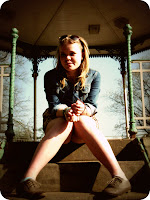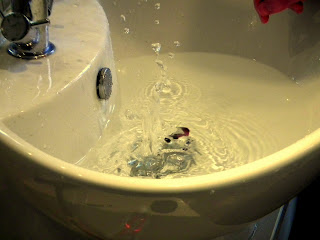Side Lighting- is good for pictures where capturing texture is important; by lighting your subjects from different angles you can get shadows to fall across them in different ways. It is particularly important with black-and- white photography because it relies on grey tones rather than colour, therefore by using side lighting you can achieve a more 3-D photo that has more depth to it because the side lighting has cast shadows across the surface and revealed tiny details and textures that would've been lost without artificially casting shadows on the object.
Front Lighting- gives your subjects a flattened effect, because the light doesn't bring out any depth in the image, this is a really good type of lighting for beauty/face shots because it gives a flawless appearace. (But because front lighting creates a flattened effect it is bad for bringing out detail in an image, it is better to light your subject from a slight angle to show slight details in your image).
Connotations of Side Lighting:
Side lighting can be used to bring out the detail in a photo, and also it can be used to create light and darkness in one shot. If your source of light is coming from the left hand side and falling onto your subject, then the right hand side will fall into the shadow cast by the left hand side. Therefore you can use side lighting to create light and dark in a single shot and highlight certain parts of your subject- this can be used cleverly to show good/bad or hint at emotions of the subject such as them having a "dark-side".
Lighting on Human Features:
Side Lighting on Males:
Side lighting can be used to accentuate male features because it creates depth in the image, the light coming from the side picks out their bone structure such as cheekbones and their jawline and makes them more refined. Side lighting also creates the effect of long shadows and bright, washed out areas, which creates strict contrasts on a face- which shows manly ruggedness.
Front Lighting on Females:
Front lighting works well on female features because it is soft and diffused, this is more flattering on a face and it is also good for softening wrinkles and imperfections under a smooth and even illumination.
Examples:
Used Front Lighting, but slightly turned head. That way the cheekbone is picking up a slight shadow- and the black and white effect highlights the contrast in the light and the dark. Side Lighting faces also picks up the texture of the skin (whereas Front Lighting flattens and evens out the skins texture), and it highlights small facial blemishes such as freckles whereas Front Lighting generally eliminates them.
Front Lighting and front on face- as you can see the light flattens the image and there's little hint of shadows that define any facial features. The light also softens any imperfections and gives the skin an even tone.
Side Lighting, and turning of face into the light makes on side of the face bright and casts the other half into shadow. The black and white effect is very effective in this photo because you can clearly see the definition of bone structure. Because I was taking the photo myself in a mirror with a desk lamp as a light source- you can see that the angles aren't perfect because my nose is casting its own shadow over the other side of my face. blems can
 bea tedn th
bea tedn th

Side Lighting, turning face away from the light puts one half of the face into total darkness and leaves the other half exposed to the full force of the light- there's less definition than in the photo above because there's less of the face in partial light, and therefore less small shadows highlighting features. Also because it isn't in black and white, you can see that it is much more difficult to see the full effect of the light because there's other colours distracting you from the features.
Side Lighting- as you can see on male faces the side lighting picks up the neck and the jawline and makes them more defined (even on my brother who still has a younger face, it picks out the features and makes them much more defined than they are normally.)
Front Lighting- because he has a young face it has the same effect as on a female face, it softenes the features and gives skin a flawless look.
Side Lighting- face turned away from the light source, puts one side into a dark shadow and the other into full-on light (long shadows and bright washed out areas). The black and white effect clearly shows the definition of darker areas and features of the face (cupids bow on the top lip, chin curve and the smile at the corner of the mouth.)
Side Lighting- almost the same photo as above, but because this one is in color you can really see the difference of how black and white makes the shadows and light areas for refined- and how strongly it picks out facial features.
































